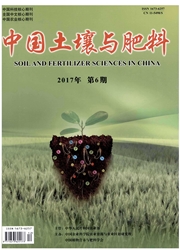

 中文摘要:
中文摘要:
The incorporation of straw in cultivated fields can potentially improve soil quality and crop yield. However, the presence of recalcitrant carbon compounds in straw slow its decomposition rate. The objective of this study was to determine the effects of different nitrogen sources, with and without the application of zinc, on straw decomposition and soil quality. Soils were treated with three different nitrogen sources, with and without zinc: urea(CO(NH2)2), ammonium sulfate((NH4)2SO4), and ammonium chloride(NH4Cl). The combined treatments were as follows: maize(M) and wheat(W) straw incorporated into urea-, ammonium sulfate-, or ammonium chloride-treated soil(U, S, and C, respectively) with and without zinc(Z)(MU, MUZ, WU, WUZ; MS, MSZ, WS, WSZ; MC, MCZ, WC, WCZ, respectively); straw with zinc only(MZ, WZ); straw with untreated soil(MS, WS); and soil-only or control conditions(NT). The experiment consisted of 17 treatments with four replications. Each pot contained 150 g soil and 1.125 g straw, had a moisture content of 80% of the field capacity, and was incubated for 53 days at 25°C. The rates of CO2-C emission, cumulative CO2-C evolution, total CO2 production in the soils of different treatments were measured to infer decomposition rates. The total organic carbon(TOC), labile organic carbon(LOC), and soil microbial biomass in the soils of different treatments were measured to infer soil quality. All results were significantly different(P<0.05) with the exception of the labile organic carbon(LOC). The maize and wheat straw showed different patterns in CO2 evolution rates. For both straw types, Zn had a synergic effect with U, but an antagonistic effect with the other N sources as determined by the total CO2 produced. The MUZ treatment showed the highest decomposition rate and cumulative CO2 concentration(1 120.29 mg/pot), whereas the WACZ treatment had the lowest cumulative CO2 concentration(1 040.57 mg/pot). The addition of NH4 Cl resulted in the highest total organic carbon(TOC) concentration(11.59 mg kg-1).
 英文摘要:
英文摘要:
The incorporation of straw in cultivated ifelds can potentially improve soil quality and crop yield. However, the presence of recalcitrant carbon compounds in straw slow its decomposition rate. The objective of this study was to determine the effects of different nitrogen sources, with and without the application of zinc, on straw decomposition and soil quality. Soils were treated with three different nitrogen sources, with and without zinc: urea (CO(NH2)2), ammonium sulfate ((NH4)2SO4), and ammonium chloride (NH4Cl). The combined treatments were as follows:maize (M) and wheat (W) straw incorporated into urea-, ammonium sulfate-, or ammonium chloride-treated soil (U, S, and C, respectively) with and without zinc (Z) (MU, MUZ, WU, WUZ;MS, MSZ, WS, WSZ;MC, MCZ, WC, WCZ, respectively);straw with zinc only (MZ, WZ);straw with untreated soil (MS, WS);and soil-only or control conditions (NT). The experiment consisted of 17 treatments with four replications. Each pot contained 150 g soil and 1.125 g straw, had a moisture content of 80%of the ifeld capacity, and was incubated for 53 days at 25°C. The rates of CO2-C emission, cumulative CO2-C evolution, total CO2 production in the soils of different treatments were measured to infer decomposition rates. The total organic carbon (TOC), labile organic carbon (LOC), and soil microbial biomass in the soils of different treatments were measured to infer soil quality. All results were signiifcantly different (P〈0.05) with the exception of the labile organic carbon (LOC). The maize and wheat straw showed different patterns in CO2 evolution rates. For both straw types, Zn had a synergic effect with U, but an antagonistic effect with the other N sources as determined by the total CO2 produced. The MUZ treatment showed the highest decomposition rate and cumulative CO2 concentration (1 120.29 mg/pot), whereas the WACZ treatment had the lowest cumulative CO2 concentration (1 040.57 mg/pot). The additio
 同期刊论文项目
同期刊论文项目
 同项目期刊论文
同项目期刊论文
 Influence of microbial inoculants on soil response to properties with and without straw under differ
Influence of microbial inoculants on soil response to properties with and without straw under differ Impacts of phosphorus and zinc levels on phosphorus and zinc nutrition and phytic acid concentration
Impacts of phosphorus and zinc levels on phosphorus and zinc nutrition and phytic acid concentration Effects of Combined Phosphorus - Zinc Fertilization on Grain Zinc Nutritional Quality of Wheat Grown
Effects of Combined Phosphorus - Zinc Fertilization on Grain Zinc Nutritional Quality of Wheat Grown Foliar zinc fertilization improves the zinc nutritional value of wheat ( Triticum aestivum L .) grai
Foliar zinc fertilization improves the zinc nutritional value of wheat ( Triticum aestivum L .) grai Effect of Zn supplementation on Zn concentration of wheat grain and Zn fractions in potentially Zn -
Effect of Zn supplementation on Zn concentration of wheat grain and Zn fractions in potentially Zn - Decomposition characteristics of maize ( Zea mays . L .) straw with different carbon to nitrogen ( C
Decomposition characteristics of maize ( Zea mays . L .) straw with different carbon to nitrogen ( C 期刊信息
期刊信息
